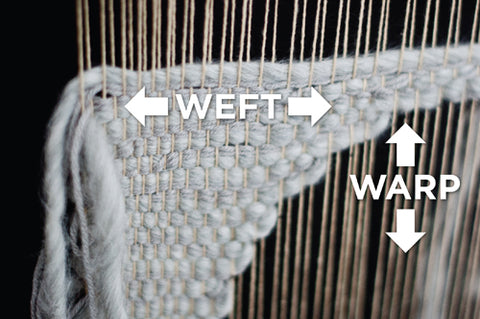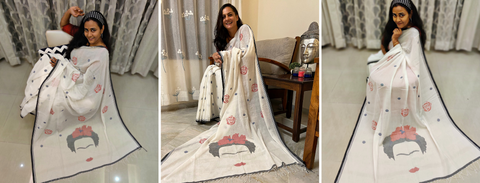
The art of weaving is exactly that—an art. It requires skill, precision and rhythm, which when repeated over and over, produces a delicate weave. Jamdani weaves, however, require more than this. Since the defining aspect of this textile are its rich motifs, which are all intricately added by hand, Jamdani is touted as the most advanced hand weaving technique in the world.
HISTORY
Jamdani was originally known as Dhakai named after the city of Dhaka, one of many ancient textile weaving centers in Bengal region. Under the Mughal Empire the Persian term Jamdani came to be in popular use, since it was the court language of the Mughals. Jamdanis are popularly known as Dhakai Jamdani or simply Dhakai. The earliest mention of jamdani and its development as an industry is found into Dhaka, Bangladesh.
Jamdani weaving is also done by weavers in Benares, Uttar Pradesh. The sari has been the mainstay of the Jamdani weaving industry. The weavers of Bengal are very proud of their ability to weave fabrics that are highly appreciated across the world.
We do not know exactly when jamdani came to be adorned with floral patterns of the loom. It is, however, certain that in the Mughal period, most likely during the reign of either Emperor Akbar (1556–1605) or Emperor Jahangir (1605–1627), the figured or flowered muslin came to be known as the jamdani. Forbes Watson in his most valuable work titled Textile Manufactures and Costumes of the people of India holds that the figured muslins, because of their complicated designs, were always considered the most expensive productions of the Dhaka looms
While many technological innovations have advanced the nature of textiles in the west, it is hard to beat the psychological pleasure of wearing muslin of the finest quality, knowing they are woven by hand.
From the middle of the 19th century, there was a gradual decline in the jamdani industry. A number of factors contributed to this decline.
Originally, the base for the Jamdani technique was muslin—the finest cloth ever woven by human hand. It shares its lineage with several ethereal muslin fabrics of India, which were lost when the erstwhile East India Company began its systematic destruction of India's textile industry in the late 18th century. Villages like Madhurapur and Jangalbari, (both in the Kishoreganj district), once famous for the jamdani industry went into gradual oblivion.
THE WEAVING PROCESS

The fine cotton yarn used for the base fabric needs starching in order to give it strength to withstand the stress on the loom.
Traditional sizing methods use a particular type of rice starch (from Kalma rice).
The yarn is then transferred onto spools or bobbins to be used for the warp and weft.
Frame looms are used for Jamdani weaving, and the warp is prepared on a warping drum.
The ends are manually drawn through the reed when a new warp is prepared.
JACQUARD LOOM & HANDLOOM
Jacquard looms have made it possible to make intricate designs, since the lifting order of the warp threads is defined by the jacquard cards. While the base fabric uses fine yarn, the ornamentation is usually done with a thicker thread.
The major difference between Handloom and Jacquard is that handloom fabrics are woven with clear warps and wefts, whereas, Jacquard fabrics are complex to weave as they are woven with repetitive patterns.
JAMDANI WEAVE
Jamdani is a hand loom woven fabric made of cotton, which was historically referred to as muslin. Jamdani is a vividly patterned, sheer cotton fabric, traditionally woven on a handloom by craftspeople and apprentices around Dhaka. Jamdani textiles combine intricacy of design with muted or vibrant colours, and the finished garments are highly breathable. Jamdani is a time-consuming and labor-intensive form of weaving because of the richness of its motifs, which are created directly on the loom using the discontinuous weft technique. Weaving is thriving today due to the fabric’s popularity for making saris, the principal dress of Bengali women at home and abroad. The Jamdani sari is a symbol of identity, dignity and self-recognition and provides wearers with a sense of cultural identity and social cohesion. The weavers develop an occupational identity and take great pride in their heritage; they enjoy social recognition and are highly respected for their skills. A few master weavers are recognized as bearers of the traditional Jamdani motifs and weaving techniques, and transmit the knowledge and skills to disciples. However, Jamdani weaving is principally transmitted by parents to children in home workshops. Weavers – together with spinners, dyers, loom-dressers and practitioners of a number of other supporting crafts – form a closely knit community with a strong sense of unity, identity and continuity.
NATIONAL HERITAGE
It is a national heritage and preserving the national heritage is a responsibility. The Indian Jamdani weave form has enormous potential to make our traditional fabrics and design gain global appeal. The weavers in recent years have discovered that it is the only weaving technique with a sustainability factor. They have also found that this technique has given them enormous scope to bring about artisanal diversity.

